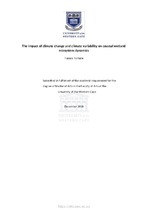| dc.description.abstract | This thesis investigates the influence of climate change and climatic variability on wetland ecosystems (coastal and inland wetlands) on the Agulhas coastal plain. Firstly, this research examines coastal wetland ecosystem resilience to sea level rise by modelling sea level rise trajectories for the Droё River wetland. The rate of sediment accretion was modelled relative to IPCC sea level rise estimates for multiple RCP scenarios. For each scenario, inundation by neap and spring tide and the 2-, 4- and 8-year recurrence interval water level was modelled over a period of 200 years. When tidal variation is considered, the rate of sediment accretion exceeds rising sea levels associated with climate change, resulting in no major changes in terms of inundation. When sea level rise scenarios were modelled in conjunction with the recurrence interval water levels, flooding of the coastal wetland was much greater than current levels for the 1 in 4 and 1 in 8 year events. The study suggests that for this wetland, variability of flows may be a key factor contributing to wetland resilience.
Secondly, the thesis examines the variability of open wetland water surface areas and their relation to rainfall to determine wetland hydrological inputs for the Nuwejaars wetland system and respective wetlands. A remote sensing approach was adopted, Landsat 5 TM and 8 OLI multispectral imagery were used to detect changes of water surfaces for the period 1989 to 2017. Water surfaces were enhanced and extracted using the Modified Normalized Difference Water Index of Xu (2006). The coefficient of variation of wetland water surface area was determined. The variability ranges from low to high for respective wetlands. A correlation analysis of wetland water surfaces and local and catchment rainfall for the preceding 1, 3, 6, 9, 12 and 24 months was undertaken. The preceding month and associated inputs explains the annual variability of surface waters. The study suggests that, the variability of wetland water surface area are related to variations to water inputs and groundwater, as well as variations in water outputs such as evapotranspiration and an outlet channel. | en_US |

